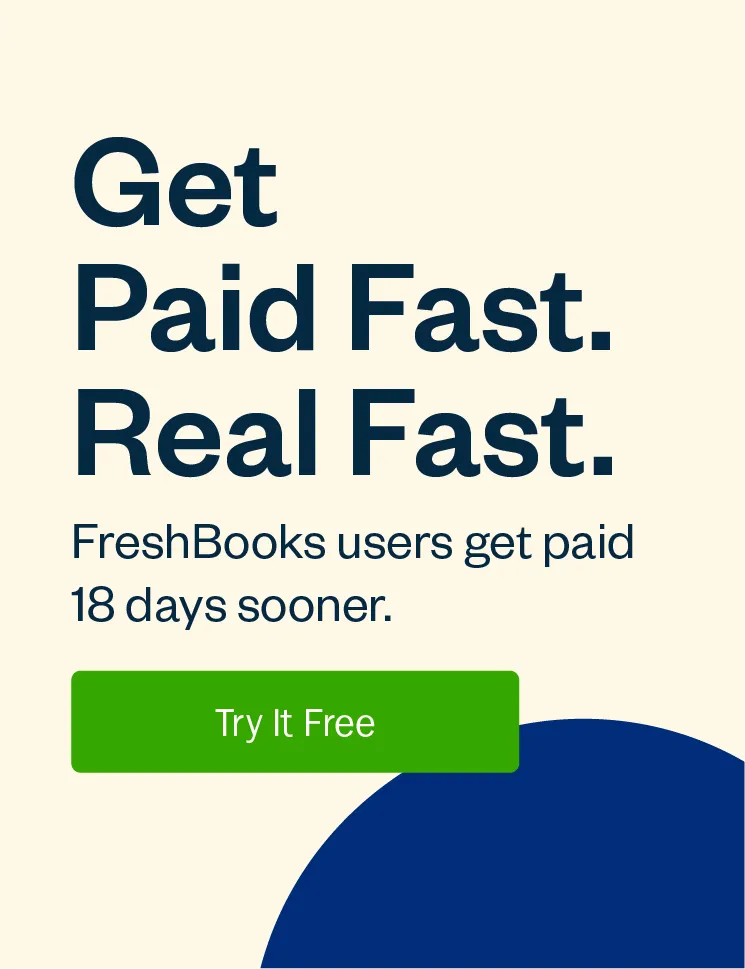Everything you need to know to get your invoices paid quickly and reliably—whether your customers are across town or across the country.

In today’s digital culture, a lot of business takes place online—which means that, as a small business owner, you may have clients across town, across the country, or even across the world.
But if you want to keep your business moving forward, it’s important to take all the necessary steps to ensure that you get paid quickly and reliably for your products and/or services—no matter where your customers are.
But getting paid as a small business owner isn’t the same as it is when you’re in an employer/employee relationship. There’s no guaranteed first paycheck a week after your hire date. You won’t receive a pay stub or benefit payments on a regular cadence. If you want your money within a timely manner and on a certain business day, you need to put the processes in place that allow you to collect that money—and collect it fast.
So, the question is, how long does it take to get paid as a small business owner? And whether you’re serving your local community or your customer base is scattered across a large geographic area, what steps can you take to make sure you receive the payments you expect, when you expect them—or even faster?
Table of Contents
How Long Does It Take To Get Paid?
First things first. Before we jump into how to get faster pay (no matter where your clients are!) let’s cover how long it takes, on average, for customers to pay their invoices—and whether the distance between you and your clients makes any difference to when their payments hit your bank account.
Distance vs. time to pay: This graph shows the mean average time to pay over distance. The blue line is the predicted mean average, and the gray area is the confidence interval for that prediction.
The data team here at FreshBooks analyzed a random sampling of over 2.7 million paid invoices and 460,000 customer-client relationships to see how long businesses typically have to wait to get paid—and whether the distance between the company and the customer had any impact on payment time.
In the data we analyzed, 57% of companies were located within 50 miles of their customers—while 43% invoiced clients well outside their immediate geographic area (between 50 and 3,000 miles).
And what did we find? In most cases, your business’ address—and how far that address is from the customers you serve—doesn’t have a major impact on how fast your invoices are settled. Most invoices are paid within 30 days of the date they’re submitted. Although, interestingly, when within that 30-day window they’re paid varied slightly based on distance—with businesses that serve long-distance customers actually getting paid a bit faster than businesses that cater to local clients.
5 Ways to Get Paid Faster—No Matter Where Your Customers Are
It doesn’t matter if your customer base is down the street or across the country; you want to get paid—and you want to get paid fast.
So how, exactly, can you speed up the payment process—and get your money faster?
Let’s take a look at four strategies you can use to get money from your customers into your bank account as quickly as possible:
1. Offer a Variety of Payment Options
Back in the day, customers didn’t have a ton of options to settle their invoices, and generally, they could either send a paper check or pay in cash.
But today, there are a ton of payment options you can offer customers—many of which can help you get paid a lot faster.
Some payment options you may want to consider offering your customers (at least if you want to get paid in fewer business days!) include:
- Online payments. Allowing your customers to pay their invoices online (for example, through FreshBooks) is arguably the quickest, most convenient way to get paid—both for you and the customer. Customers can pay using a variety of methods (like a debit card, credit card, business checking account, or PayPal) and you receive funds quickly—sometimes on the same day.
- Direct deposits. If your customers are other businesses, they may want to pay you through direct deposit—which, as the name suggests, deposits funds directly into your bank account. Similar to online payments, direct deposits can be a great way to get paid quickly—particularly if you work with the customer on a recurring basis. (Just keep in mind that, in order to receive payments through direct deposit, you’ll need to provide certain financial information—for example, your social security number or EIN, the routing number for your business checking or savings account, and potentially a voided check—on a direct deposit form and submit it to your client’s human resources department.)
- Wire transfers. Wire transfers, which send money from one bank account to another, are another fast way to get the money your customers owe you—but again, the customer will need to obtain information related to your finances (which really only makes sense in an established B2B customer relationship) and both you and the customer will likely have to pay cash fees to initiate/receive the transfer.
- Physical checks. Some customers, no matter how convenient other payment methods may be, will still want to pay with paper checks—so even if it’s not the most convenient or timely way to collect a payment, you’ll still want to offer paying with a paper check as an option.
Bottom line? The whole process of collecting cash/payment from your customers will get shorter if you give them a variety of quick, easy ways to pay their invoices—so make sure to offer them a variety of payment options.
2. Educate Your Customers so They Embrace Faster Payment Methods
Offering your clients a variety of payment options is one part of the equation. But if you want them to embrace the options that allow you to get cash faster, you need to educate them on why those options are the payment methods they should use.
This process will look a little different depending on your customers (and how familiar they are with different payment methods), but may include:
- Selling them on the benefits. If there is a payment method that both helps you get paid faster and offers benefits to the customer—that’s a win-win—and you’ll want to show them why. Make sure to walk your customers through how your preferred payment methods actually benefit them (for example, if you want clients to pay you through direct deposit, you can show them how they can add your information to their payroll software—and instead of having to manually process your payments and send a paycheck each pay period or month, they can just automate the process and save themselves the time and effort.)
- Educating them on how the payment method works. Some clients aren’t familiar with how different payment methods work—so, if you want them to use them, you’ll need to walk them through how it works. For example, if a client is unfamiliar with online payments, you may want to show them how to initiate a secure payment through your FreshBooks invoice—or, if they’re not clear on how direct deposit works, walk them through the basics (like how long a direct deposit takes to clear from their bank account and any form or initial application they’ll need to submit to their bank to initiate the process).
- Make yourself available to answer questions. As you introduce new payment methods, your customers may have questions—and if you want your customers to adopt those payment methods (and get your money faster!), make sure to make yourself available to answer those questions.
3. Incentivize Your Customers to Pay Faster
If you want your customers to pay you faster, the best thing you can do? Give them an incentive to pay you faster.
Reward your customers that pay their invoices before their due date. For example, you may offer clients a small discount on next month’s invoice if they pay within the first week or 10 business days of receiving an invoice. Or, if a discount doesn’t feel like the right move, you might offer additional benefits (like an extra 30-minute consulting call or a free product) who pay their invoices ahead of schedule.
4. Penalize Customers That Pay Late
Positive incentives can be a great way to get your customers to pay your invoices faster. But negative incentives can be just as (if not more!) powerful—so consider penalizing your customers that pay their invoices late (for example, by tacking on late fees to their invoices).
Facing a penalty will make customers think twice about paying your invoices late—and can push chronically late payers to settle their invoices in a more timely manner.
5. Track Your Payments
When it comes to their employees, employers track everything; in order to process payroll, they need to track an employee’s start date for the job, pay date, the hours worked in a pay period, gross pay, and any employee benefit payment. All of that data helps them better understand the financial implications of each employee—which can ultimately help them improve and optimize their business.
And if you want to improve and optimize your payment processes, you’ll want to track the same volume of data for your customers.
Collect as much payment data as possible as you can on each customer—including when you send your invoice when payment is due, and when you ultimately collect. Over time, you’ll be able to identify which customers consistently pay on time, which pay faster than on time, and which have a habit of paying late—information you can use to drive your payment strategy and get paid faster across the board.
Don’t Be Shy, It’s Your Hard Earned Money
At the end of the day, you did the work and need to get paid for it right? While it’s fair that from time-to-time things are forgotten, accounts payable make a mistake, or someone couldn’t get the direct deposit to work, you’re still stuck waiting weeks or months for payment.
Be as loud as you need to be to get paid because someone else’s problems to get you the money you worked for aren’t your problems.

Written by Deanna deBara, Freelance Contributor
Posted on March 20, 2013

 6 Hit Songs About Money (And What Business Owners Can Learn From Them)
6 Hit Songs About Money (And What Business Owners Can Learn From Them) How to Accept Online Payments to Scale Faster and Smarter
How to Accept Online Payments to Scale Faster and Smarter Using Student Loans to Start a Business: Is It Worth the Risk?
Using Student Loans to Start a Business: Is It Worth the Risk?


![12 Silly Invoicing Mistakes That a Cloud Accounting Solution Will Save You From Making [Infographic] cover image](https://staging-web-k8s.freshenv.com/blog/wp-content/uploads/2017/11/invoicing-mistakes-1-226x150.jpg)


